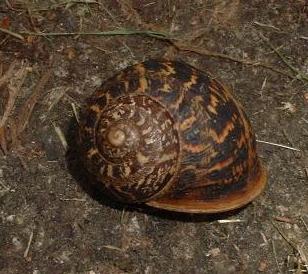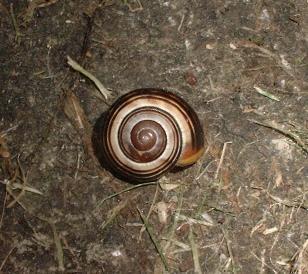Snails are similar in most ways to Slugs apart from their shell. This is their most striking feature and close study reveals wonderful geometric patterns. Also the palatable species have been a source of food for many years - some archeological evidence suggests that the snail was one of the first animals to be domesticated about 12,000 years ago. Although the larger Roman Snail (Helix pomatia) is eaten as Escargo, the Garden Snail (H. aspersa) is served as Petit Gris in France. The latter is still prepared as a dish known as Mendip Wallfish in Somerset; boiled in cider and served up in the shell in a herb butter. They must be purged first to ensure they have not been eating something harmful by feeding them on lettuce or cabbage for 10 days.
As part of the Slow Art Movement vegetarian, French artists Elizabeth Saint-Jalmes & Cyril Leclerc take the culinary snails and use them in their art installation Slow Pixel which is performed on an illuminated concert hall floor. The snails crawl around and the vibrations of bass notes stimulate their movements. After the performance the snails are released. Looking for faster movement, the world snail racing championship is held in Norfolk.Apart from this they can be just as pestilent as their slimy cousins, the slugs, but they have other friends, most notably American novelist Patricia Highsmith author of the Mr Ripley series of novels, who preferred animals to people. She kept about 300, carrying some of them around in her handbag attached to a lettuce - once bringing them to a dinner party and letting them crawl on the table to the disgust of fellow guests. It is believed that she was fascinated by the fact that they are hermaphroditic. When moving to live in France where the importation of snails is banned due risks to the commercial production, she smuggled her 'pets' six at a time under her breasts as she travelled to the country.
Snails also featured in some of her short stories notibly 'The Snail Watcher' in which the man of the title was overcome by snail slime. Giant carniverous snails feature in another tale.
Garden Snail (H. aspersa) White-lipped Banded SnailThe Garden Snail Helix aspersa (above left) can grow to 38 mm wide with five dark bands on a fawn background. They are usually found during the day behind stones and clinging to walls where they are sheltered by a climbing plant. They become active at night or occasionally during dull moist days, when they can avoid predators and drying sunshine. They can live for about three years.
In a recent Royal Horticultural Society survey about one fifth of the respondents admitted throwing snails over the fence into a neighbour's garden. However this may be a waste of time as an earlier study carried out by a housewife using paint to mark the shell found that snails can "home" and will return from a distance of up to 10 metres.
In drier climates snails can stay dormant in their shells for up to six years until conditions are favourable. Freshwater snails have been affected by antidepressants residues of which are excreted from humans and released in sewage. This makes their slime less sticky so reducing their ability to cling to surfaces. Because the slime or pedal mucus to give it a more scientific name, can propel the snail even in the wet, a surgical glue has been developed from it. The carniverous Rosy Wolf Snail follows the slime trail to find its prey and it can help a snail find a mate.
The spiral of the Garden Snail is clockwise, but there is a rare genetic mutation which causes it to be anti-clockwise. One of these was discovered in London in 2015 and researchers at Nottingham University appealed for others to try and breed some more. Due to the position of the genitalia and everything being reversed, they can only mate with another of their kind. Two others were discovered and over two hundred offspring produced, but none had the mutation due to the recessive nature of the gene. It is hoped that subsequent generations may express the trait. The first one discovered recently was called Jeremy after the leader of the Labour Party at the time as it too was a "lefty", it died in October 2017 after producing 56 offspring.The White-lipped Banded Snail is about 16 mm wide and can be all yellow, but usually there are a number of darker bands in variable colours and numbers.
As with slugs each snail has male and female reproductive organs, but they do mate to exchange sperm. The male genitalia are located on the right side of the head behind the eye tentacle. The exchange occurs on a warm, wet night and afterwards they part to go and lay up to 40 spherical, fertilised eggs in a shallow depression. After a month small replica snails hatch out and the shell enlarges as they grow.
Like slugs they have thousands of teeth used for rasping off vegetable matter. The teeth were found to be made of the toughest natural material, but limpet teeth are now considered to be stronger. The average number of teeth is about 14,000, but some species have over 20,000 of the microscopic barbs arranged in rows facing backwards on the tongue-like radula.Major predators are the Song Thrush and Blackbirds which break the shell on a stone.
Snails are a bit easier to find and easier to pick up, due to their shells, so inspect the undersides of objects and pick them off. Ground-feeding birds such as Thrushes and Blackbirds love them and like a boulder to smash them against. See the monograph on Slugs for more methods to defeat them.
Slugs and snails can carry the larva of the lungworm parasite, Angiostrongylus vasorum, which can be lethal to dogs. More details are given in the monograph on Slugs
Back to GARDEN CREATURES
